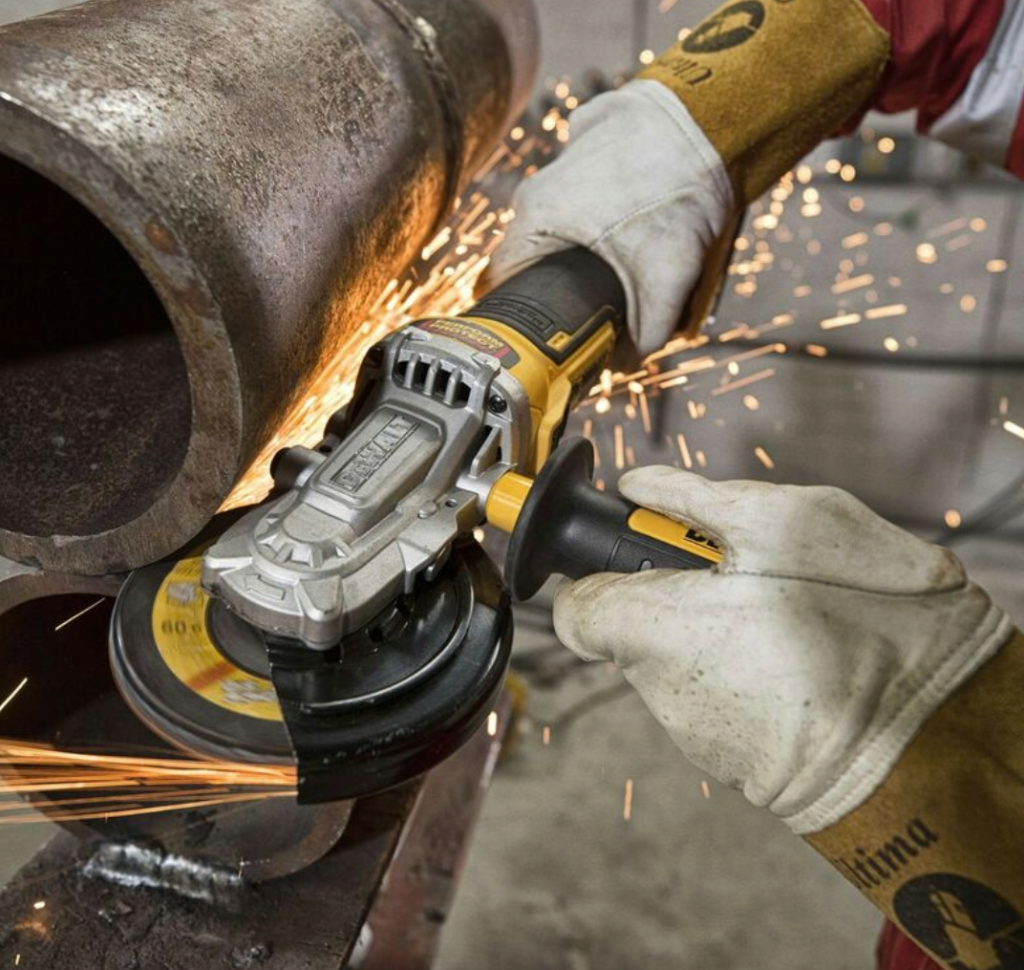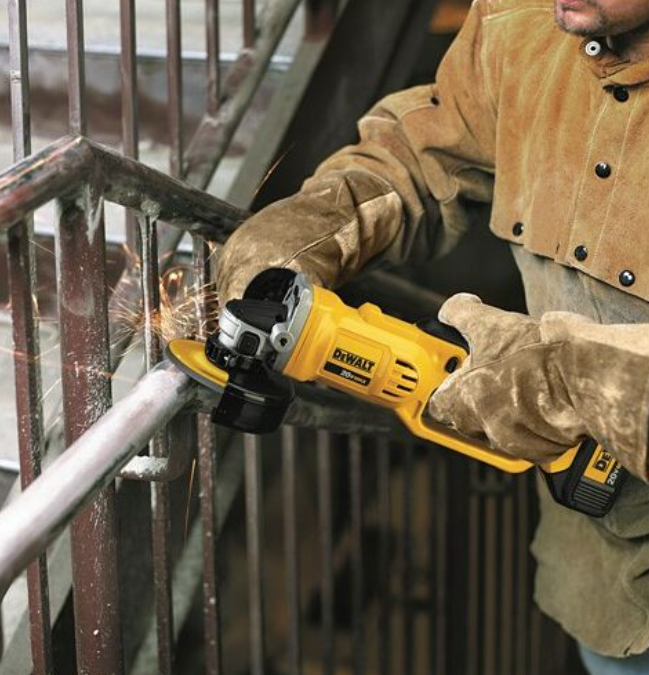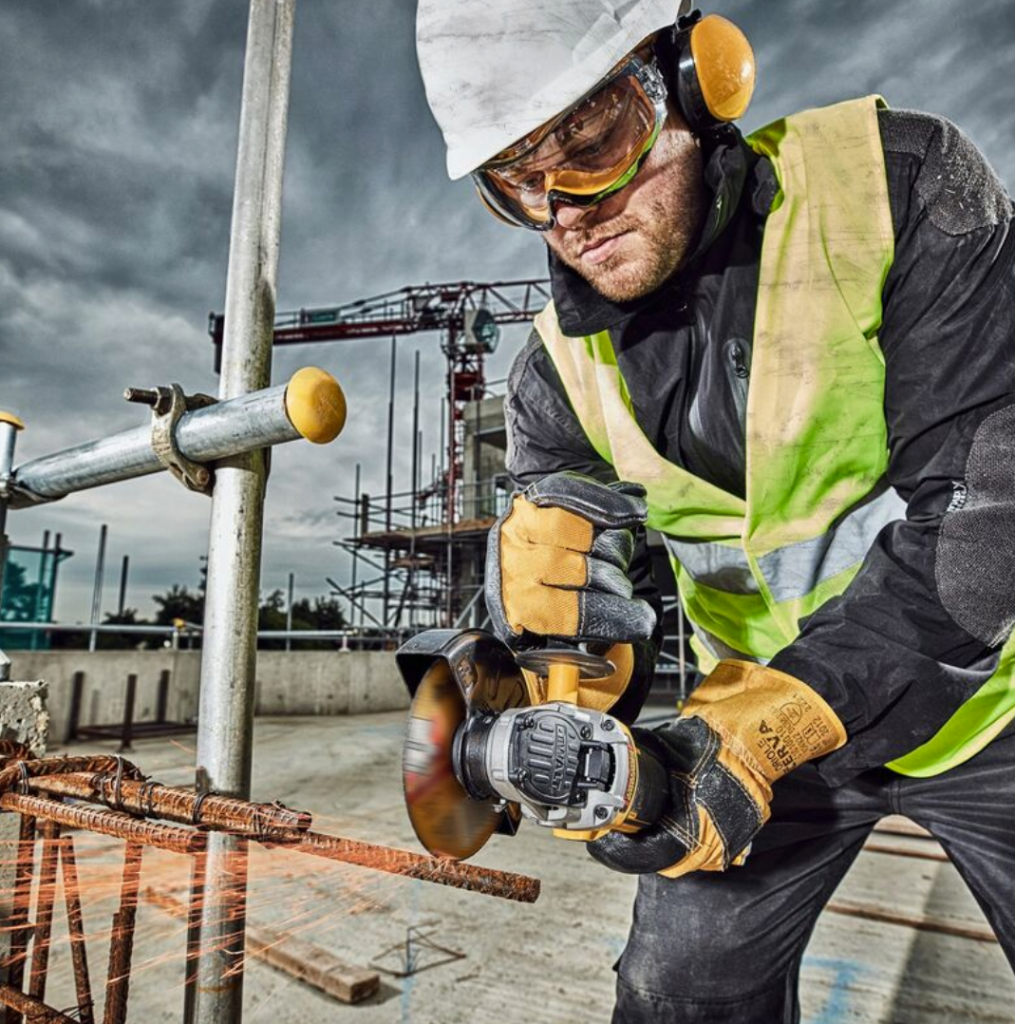The DeWalt Angle Grinder is a powerhouse tool with immense versatility. Whether you’re a DIY enthusiast or a pro, this tool can tackle various tasks, from precision cutting to smoothing rough surfaces.
To make the most of this tool, you must understand its features, functions, and safety measures. In this concise guide, we’ll walk you through using the DeWalt Angle Grinder effectively and safely. From setup to attachment selection, speed adjustment, and everyday tasks like grinding and cutting, you’ll gain the knowledge you need to harness this tool’s full potential.
Whether starting a new project or honing your skills, join us to become a proficient DeWalt Angle Grinder user and unlock endless possibilities for your DIY and professional endeavours.
Safety First: Preparing for Your Angle Grinder
Safety is paramount when using any power tool. This section will delve into the essential safety precautions you should take before starting your DeWalt Angle Grinder. From wearing the right protective gear to ensuring a secure workspace, we’ll cover everything you need to know to keep yourself and others safe.

Assembling and Setting Up Your DeWalt Angle Grinder
Before you can use your angle grinder, you must assemble and set it up correctly. We’ll walk you through the step-by-step process of assembling your DeWalt Angle Grinder, including attaching accessories, adjusting handles, and ensuring everything is in perfect working order.
a. Unboxing and Component Identification
When you first unbox your DeWalt Angle Grinder, please take a moment to familiarize yourself with its components. Typically, you’ll find the angle grinder body, a side handle, a safety guard, and a spindle lock button. Understanding each part’s purpose is essential before assembly.
b. Safety Gear Preparation
Safety should always be your top priority. Before starting the assembly, wear the appropriate safety gear, including safety glasses or goggles, hearing protection, and gloves. These items will shield you from sparks, debris, and noise.
c. Attaching the Side Handle
Begin by attaching the side handle to the angle grinder. The side handle provides stability and control during operation. Locate the handle’s designated attachment point on the grinder body, align it properly, and securely tighten it. Ensure the handle is positioned for comfortable and safe use, considering the direction of the grinding or cutting task.
d. Installing the Safety Guard
Next, it’s time to install the safety guard. This guard is a protective barrier between the grinding or cutting disc and your hands and body. Line up the guard with the grinder’s spindle and tighten it securely. Ensure the guard is correctly positioned to shield you from sparks and debris generated during operation.
e. Mounting the Grinding or Cutting Disc
Please choose the appropriate grinding or cutting disc and mount it on the grinder’s spindle. Ensure that it fits securely and aligns with the safety guard. Use the spindle lock button to immobilize it, making it easier to tighten or loosen the disc nut. Once the disc is in place, release the spindle lock button.
f. Checking for Proper Alignment
Before using your DeWalt Angle Grinder, visually inspect the assembly to ensure everything is aligned and tightened. Any loose components or misalignment could lead to dangerous situations during operation, so take the time to double-check.
g. Power Connection and Testing
Finally, before powering your angle grinder, ensure it’s plugged into a suitable power source with the right voltage. Once connected, give the grinder a brief test run without applying it to any workpiece. This allows you to verify that everything functions correctly, from the motor to the disc rotation.
With your DeWalt Angle Grinder correctly assembled and set up, you can move on to your specific tasks with confidence and safety in mind. Proper assembly ensures efficient performance and minimizes the risk of accidents, making your work with the angle grinder more productive and secure.

Choosing the Right Attachments for the Job
An angle grinder’s versatility largely depends on the attachments you use. We’ll discuss the various attachments available for your DeWalt Angle Grinder and guide you in selecting the right ones for specific tasks. Whether it’s grinding discs, cutting discs, or wire brushes, you’ll learn which accessories to use for optimal results.
Types of cutting discs
Cutting discs, also known as abrasive or cutoff discs, come in various types and are designed for specific applications. Each type of cutting disc has unique properties that make it suitable for cutting different materials. Here are some common types of cutting discs and what they are used for:
a. Metal Cutting Discs:
- Type: Thin, reinforced with fibreglass mesh.
- They are used for Cutting metal, including steel, stainless steel, and aluminium. They are versatile and can handle a wide range of metal thicknesses.
b. Masonry Cutting Discs:
- Type: Thicker and abrasive, often with a diamond-coated edge.
- They are used for Cutting masonry materials such as concrete, brick, stone, and tile. They are essential for construction and remodelling projects.
c. Tile Cutting Discs:
- Type: Thin and coated with abrasive materials or diamond grit.
- They are used for the precision cutting of ceramic and porcelain tiles. They provide clean and chip-free cuts, making them ideal for tile installations.
d. Wood Cutting Discs:
- Type: Thicker than metal cutting discs, often with carbide-tipped teeth.
- Used for Cutting wood, including lumber and plywood. They are essential for carpentry and woodworking projects.
e. Plastic Cutting Discs:
- Type: Designed to minimize heat generation and melting.
- They are used for Cutting various plastics, acrylics, and PVC. They prevent materials from melting and adhering to the disc.
f. Diamond Cutting Discs:
- Type: Embedded with diamond particles.
- They are used to precisely cut hard and abrasive materials like granite, marble, glass, and ceramics. Diamond-cutting discs provide clean and precise cuts in these challenging materials.
g. Multi-Purpose Cutting Discs:
- Type: Versatile and designed for various materials.
- Used for: These cutting discs are suitable for cutting various materials, including metal, wood, plastic, and more. They are a convenient option for tasks requiring flexibility in material choice.
h. Special Cutting Discs:
- Type: Customized for specific applications.
- Used for: Some cutting discs are tailored for unique tasks, such as cutting concrete with embedded rebar, cutting fibreglass, or performing detailed cuts in jewellery making.

Types of grinding discs
Grinding discs for angle grinders come in various types and are designed to tackle different grinding and abrasive tasks. Choosing a grinding disc depends on your working material and the desired finish or result. Here are some common types of grinding discs for angle grinders and their respective uses:
a. Metal Grinding Discs:
- Type: Made of abrasive grains bonded to a metal disc.
- They are used for Grinding and smoothing metal surfaces welds, and removing rust or paint. They are versatile and can handle various metals.
b. Masonry Grinding Discs:
- Type: Designed with abrasive grains for heavy-duty masonry work.
- They are used for Grinding and shaping masonry materials such as concrete, brick, and stone. They can also be used for removing old mortar.
c. Concrete Grinding Discs:
- Type: Similar to masonry discs but often designed for smoother finishes.
- They are used for Smoothing and levelling concrete surfaces, preparing concrete for coatings or resurfacing, and removing imperfections in concrete floors.
d. Abrasive Flap Discs:
- Type: Consists of overlapping abrasive flaps.
- They are used for Blending, deburring, and finishing tasks. They are versatile and can handle both metal and non-metal materials.
e. Wire Brush Discs:
- Type: Equipped with wire bristles or brushes.
- They are used for Removing rust, paint, and corrosion from metal surfaces. They are also effective for cleaning welds and preparing surfaces for painting.
f.Diamond Grinding Discs:
- Type: Embedded with diamond particles for durability and precision.
- They are used for Grinding and shaping hard materials like concrete, stone, granite, and ceramics. Diamond discs provide smooth and precise results.
g. Carbide Grinding Discs:
- Type: Equipped with carbide teeth or tips.
- They are used for Grinding and shaping hard materials, including metal, wood, and plastics. Carbide discs are durable and excel at removing material quickly.
h. Sanding Discs:
- Type: Made with abrasive sandpaper-like material.
- They are used for Sanding and finishing tasks, including smoothing wood surfaces, removing paint, and preparing surfaces for coatings.
i. Polishing Discs:
- Type: Designed for polishing applications.
- They are used for Achieving a high-gloss finish on metal, stone, or other materials. They are commonly used in the automotive, jewellery, and metalworking industries.
j. Specialty Grinding Discs:
- Type: Customized for specific applications.
- Used for: Some discs are tailored for unique tasks, such as cutting and grinding ceramics, sharpening tools, or grinding glass.
Mastering Speed Settings for Precision Work
To achieve precise results in your work with an angle grinder, mastering speed settings is crucial. The speed control on your grinder allows you to adapt to the specific demands of your task. Lower speeds are ideal for precision tasks, preventing material overheating or unwanted material removal. Higher speeds, on the other hand, enable more aggressive material removal. Understanding when and how to adjust these settings ensures you can work with finesse, accuracy, and efficiency, regardless of the material you’re working on.
Grinding with Precision: Tips and Techniques
Grinding with precision requires attention to detail and the right techniques. Start by maintaining a steady hand and a consistent pressure on the angle grinder. Keep the tool moving to prevent over-grinding in one spot. Use the full width of the grinding wheel to ensure an even finish. For accuracy, mark your grinding lines or follow a guide. Finally, periodically check your progress and make adjustments as needed. These tips and techniques will help you achieve a smooth, uniform surface and avoid common grinding pitfalls.
Cutting Like a Pro: How to Use Your Angle Grinder
To cut like a pro with an angle grinder, securely clamp the workpiece to a stable surface. Use the appropriate cutting disc for the material you’re working on, and ensure it’s properly attached to the grinder. Maintain a firm grip on the tool and make precise, controlled cuts, avoiding excessive force. Move the grinder smoothly through the material, allowing the disc to work. For straight cuts, use a guide or mark a precise cutting line. Lastly, always wear safety gear and follow safety precautions to prevent accidents when cutting with your angle grinder.
Maintaining Your DeWalt Angle Grinder for Longevity
Ensuring the longevity of your DeWalt Angle Grinder involves regular maintenance. After each use, clean the tool thoroughly to remove dust and debris. Check for loose components and tighten them as needed. Lubricate moving parts to prevent wear and rust. Inspect the power cord for damage and replace it if necessary. Regularly replace worn-out grinding or cutting discs. Storing the grinder in a dry, protected area when not in use also extends its lifespan. These maintenance steps will keep your DeWalt Angle Grinder in peak working condition, ensuring its durability and reliability for years.
Common Mistakes to Avoid When Using an Angle Grinder
When using an angle grinder, avoid common mistakes to ensure safety and efficiency. Firstly, don’t skip safety gear—always wear eye and ear protection, gloves, and a dust mask. Never use a damaged or improperly installed cutting or grinding disc. Avoid excessive force; let the tool’s weight do the work. Don’t overload the grinder with heavy tasks, and maintain a stable stance to prevent loss of control. Lastly, never leave the grinder unattended while it’s running, and always disconnect it from power when changing accessories or performing maintenance.
Read more about DeWalt Angle Grinders
Safety Tips and Best Practices for Angle Grinder Users
Safety is paramount when using an angle grinder. Wear appropriate personal protective equipment, including safety glasses or goggles, hearing protection, gloves, and a dust mask. Ensure your work area is clear of flammable materials and keep bystanders safe. Before starting, inspect the tool for damage and secure workpieces properly. Always hold the grinder with a firm grip and maintain a stable stance. When cutting or grinding, move the tool smoothly and avoid excessive force. Lastly, disconnect the power source when changing accessories, and store the grinder in a safe, dry location to prevent accidents.
Leave a Reply